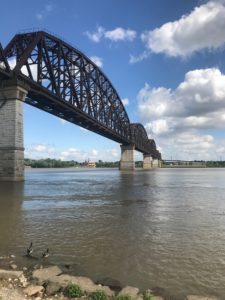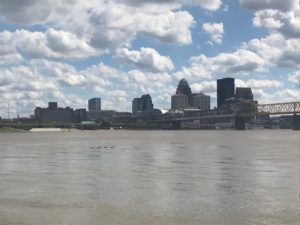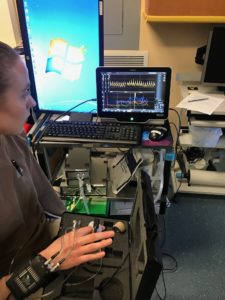Hi, my name is Elena Scheibler and I attend Telluride High School. For the past week, I have been interning for Pediatric Spinal Cord Research and Rehabilitation in Louisville, Kentucky. I arrived late on June 10thand was picked up by my host brother and his friends. I started my internship the very next morning, so I was given a ride to ensure that I was familiar with my surroundings and was able to arrive at the right location. Right from the start, I was welcomed by some of the nicest people who showed me the different facilities where I would be for most of the day. There are also two other interns working there, with whom I share two cubicles.
My first day started with getting to know the research center and familiarizing myself with the kind of research and rehabilitation that takes place. I even got to see an experiment being done at the end of the day! Once the day was over, my host brother picked me up and showed me some of Louisville by renting electric scooters that you could take across a bridge, giving an amazing view of the city.
The very next day, I was introduced to the safety and feasibility study my team would be conducting, which focuses on applying stimulation to the spine in order to improve the trunk control and posture in children with spinal cord injury. The study is focused on whether this is possible in children, as it has already been conducted successfully in adults. I also received the opportunity to see a pig dissection, wherein they removed the spine to examine and conduct research on it, which was wildly fascinating. Wednesday afternoon, a mock trial was run for the safety and feasibility study, in order to ensure that everyone was aware of their roles and that things were running smoothly. This study is performed by applying a multitude of electrodes to the patient’s body in order to record data of any muscular activity. Xsens, which are small orange devices, are also applied in order to recreate the child’s body on a screen. This collects data and shows the body’s angular position and acceleration. The child is then sat onto a force plate that records the child’s center of gravity and any changes in position or pressure. This is important because a multitude of tests that are run include having the child lean forwards, backwards, left and right as far as possible while maintaining balance. Another intern and I were put in charge of monitoring the CV parameter, which means that we are monitoring the patient’s blood pressure, recording it, and gaining ECG data. It was amazing to see the difference in trunk control and posture in the subjects when the spine was being stimulated versus when it was not. Later that day, I was able to go swimming in my host family’s pool. Throughout the week, they showed me various sites throughout Louisville and introduced me to Krispy Kreme donuts (which were amazing). On Thursday, the study began with its first two subjects! I was also able to see a therapy session in which a child with a spinal cord injury is placed in a harness above a treadmill and therapists move their legs to resemble walking. The idea behind this is that the spinal cord has a degree of plasticity and that moving their legs will send sensory information which the spinal cord would uptake. Over time, this will help patients regain certain functions. Thus far, my internship has been amazing, and I have learned so much regarding the spinal cord, the patients, and the methods used to conduct experiments. This past weekend was spent exploring Louisville further by bike and eating some amazing empanadas. I can’t wait to learn and experience more this coming week! 


One of the machines used to monitor the BP is shown here. It is attached to the wrist and finger, in order to continuously monitor the BP for about 3-5 minutes

There are no comments published yet.